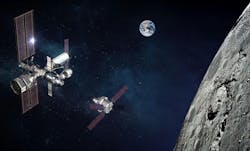Researchers eye space propulsion, remote sensing, and machine autonomy for lunar situational awareness
ARLINGTON, Va. – U.S. military space researchers are asking industry to develop machine autonomy, remote sensing, and space propulsion to enable future lunar-orbiting satellites to navigate and maneuver in stressing orbital conditions to locate resources on the moon like proven sources of water.
Officials of the U.S. Defense Advanced Research Projects Agency (DARPA) in Arlington, Va. issued a program solicitation (DARPA-PS-25-07) on Monday for the Lunar Assay via Small Satellite Orbiter (LASSO) project.
LASSO seeks to develop autonomous spacecraft navigation, spacecraft propulsion, remote sensing, spacecraft to operate efficiently in the area of space between Earth and the moon, with an emphasis on orbital operations around the moon.
The project's overall goal is to develop enabling technologies in space situational awareness to help avoid operational surprises between the Earth and the moon. This calls for improvements in sensors, processing algorithms, and navigation techniques.
Spacecraft maneuvering
Maneuverability for spacecraft is key to space situational awareness in space between Earth and the moon, using several cost-efficient maneuvering satellites to monitor changing conditions, researchers say.
LASSO will benefit DARPA, and eventually the U.S. Space Force, by establishing new technologies for space maneuverability and situational awareness.
The project also seeks new spacecraft able to operate at altitudes as low as six or seven miles above the moon to determine all areas that contain usable water with a resolution of four-square kilometers. LASSO also seeks to develop an autonomous spacecraft with a space propulsion system able to navigate low enough to make precise sensor measurements.
Spacecraft operations
LASSO phase 1A focuses on concept design, and phase 1B focuses on detailed subsystem, satellite and mission planning design. The project's second phase will seek to build the spacecraft and prepare for launch and operations.
Companies interested should email abstracts no later than 27 May 2025 to DARPA at [email protected]. Those submitting promising abstracts may be invited to give oral presentations and submit formal proposals.
Email questions or concerns to DARPA at [email protected]. More information is online at https://sam.gov/opp/82e0f799959f4a4ba8222e6aafb6ec92/view.
About the Author
John Keller
Editor-in-Chief
John Keller is the Editor-in-Chief, Military & Aerospace Electronics Magazine--provides extensive coverage and analysis of enabling electronics and optoelectronic technologies in military, space and commercial aviation applications. John has been a member of the Military & Aerospace Electronics staff since 1989 and chief editor since 1995.
